GEODESIC CIRCLE OF A SURFACE
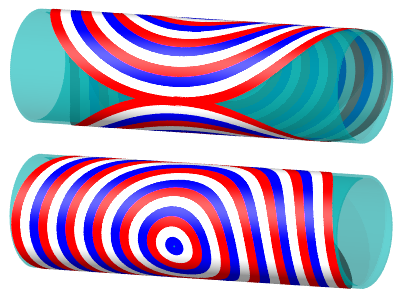

| next curve | previous curve | 2D curves | 3D curves | surfaces | fractals | polyhedra |
GEODESIC CIRCLE OF A SURFACE


| Notion studied by Catalan in 1843 (J. E. P.,1843,
29e cahier, pages 121-156), Delaunay in 1843 ( J.
M.,1843, vol. 8, pages 231-244), Darboux in 1883 (C.
R.,1883, vol.96, p.54) , and Whittemore
in 1901.
See also [Blaschke p. 99] |
| Differential equation for a surface |
The notion of geodesic circle is the generalization to any surface of the notion of circle in the plane.
There are two major definitions, that are not equivalent in general:
DEF 1: locus of the points of the surface located at given geodesic distance (the geodesic radius) from a center (located on the surface).
| DEF 2: maximal curve with constant nonzero geodesic
curvature - the case of zero curvature gives the geodesic
lines. The radius of this geodesic circle is then the reciprocal
of its curvature. In other words, the sphere that contains the osculating
circle of the curve and the center of which is in the tangent plane of
the surface has a constant radius. Figuratively, this definition corresponds
to the trajectories of observers moving on a surface turning left or right
with a constant angle, or of small cars the direction of which is blocked
in a given position.
Nota: geodesic circles are not, in general, skew circles (with constant curvature). |
 |
Examples:
- the geodesic circles of the
plane or the sphere are the usual circles (but, be careful: circles (in
the classic sense) traced on a surface are not, in general, geodesic circles)
| Parallel circle with colatitude The equator has radius |
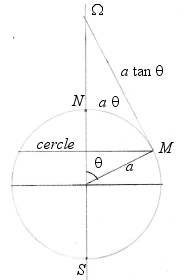 |
- the geodesic circles of a cylinder or a cone, and more generally of developable surfaces, are the curves that give circles when the surface is applied onto a plane; concretely, geodesic circles can be seen as the edges of circular pancakes applied onto the surface.
Special case of the cylinder of revolution:
| Parametrization for a geodesic circle with radius b
on a cylinder with radius a: It has double points as soon as its diameter is greater than or equal to the cylinder's circumference ( Compare to the pancake curve . |
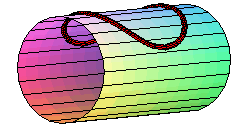 |
 the "circle" passes by its center... |
| Parametrization of the cylinder by the polar geodesic
coordinates, the coordinate lines of which are circular helices and geodesic
circles: |
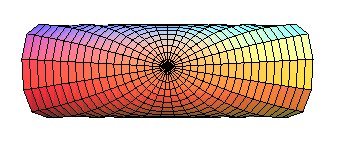 |
 |
Special case of the cone of revolution:
| Parametrization for a geodesic circle with radius b,
center located a distance a from the vertex of a cone with half-angle Remark: for fixed u and variable b, the above formula gives the geodesics passing by the center of the circle. See the special case a = b on the page of the cone of revolution. |
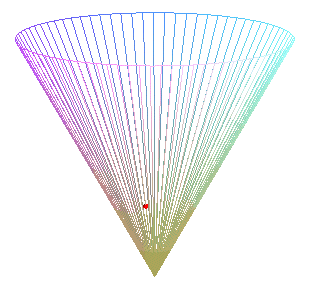
Animation for a circle with radius ranging from 0 to 2a. |
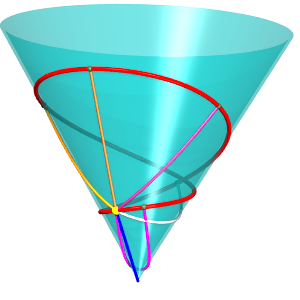
At the end of this animation, the circle passes by its center. Some geodesics passing by the center (yellow point) are traced. |
| A case where the two definitions are not equivalent:
the rectangular
hyperbolic paraboloid.
On this figure are traced the geodesics passing by O
and the points at given geodesic distance from O, that show the
geodesic circles of the first definition.
Figures made thanks to Rhinoceros by Robert March. |
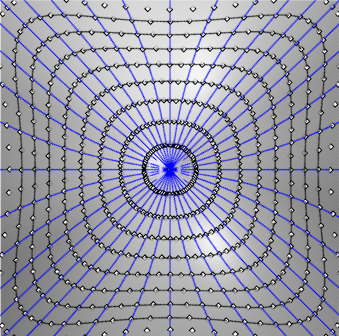 |
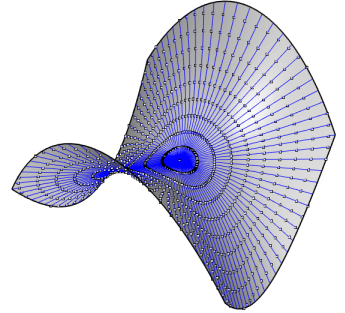 |
| Other example: the monkey saddle. |
 |
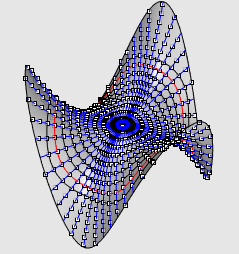 |
| Third example: the torus (see also the specific page on geodesics). |
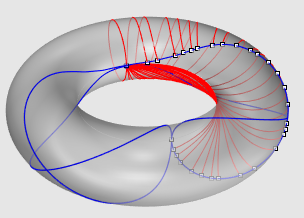 |
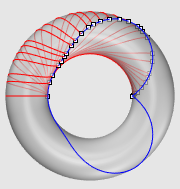 |
The geodesic ellipses have also been defined as
the loci of the points for which the sum of the geodesic distances from
two fixed points is constant.
For example, the curvature lines of the ellipsoid
are the geodesic ellipses with foci the umbilics.
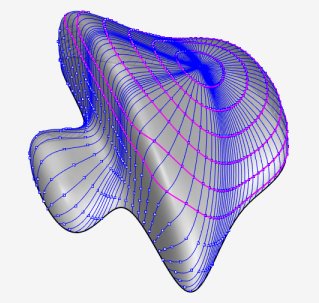
| next curve | previous curve | 2D curves | 3DÂ curves | surfaces | fractals | polyhedra |
© Robert FERRÉOL
2018